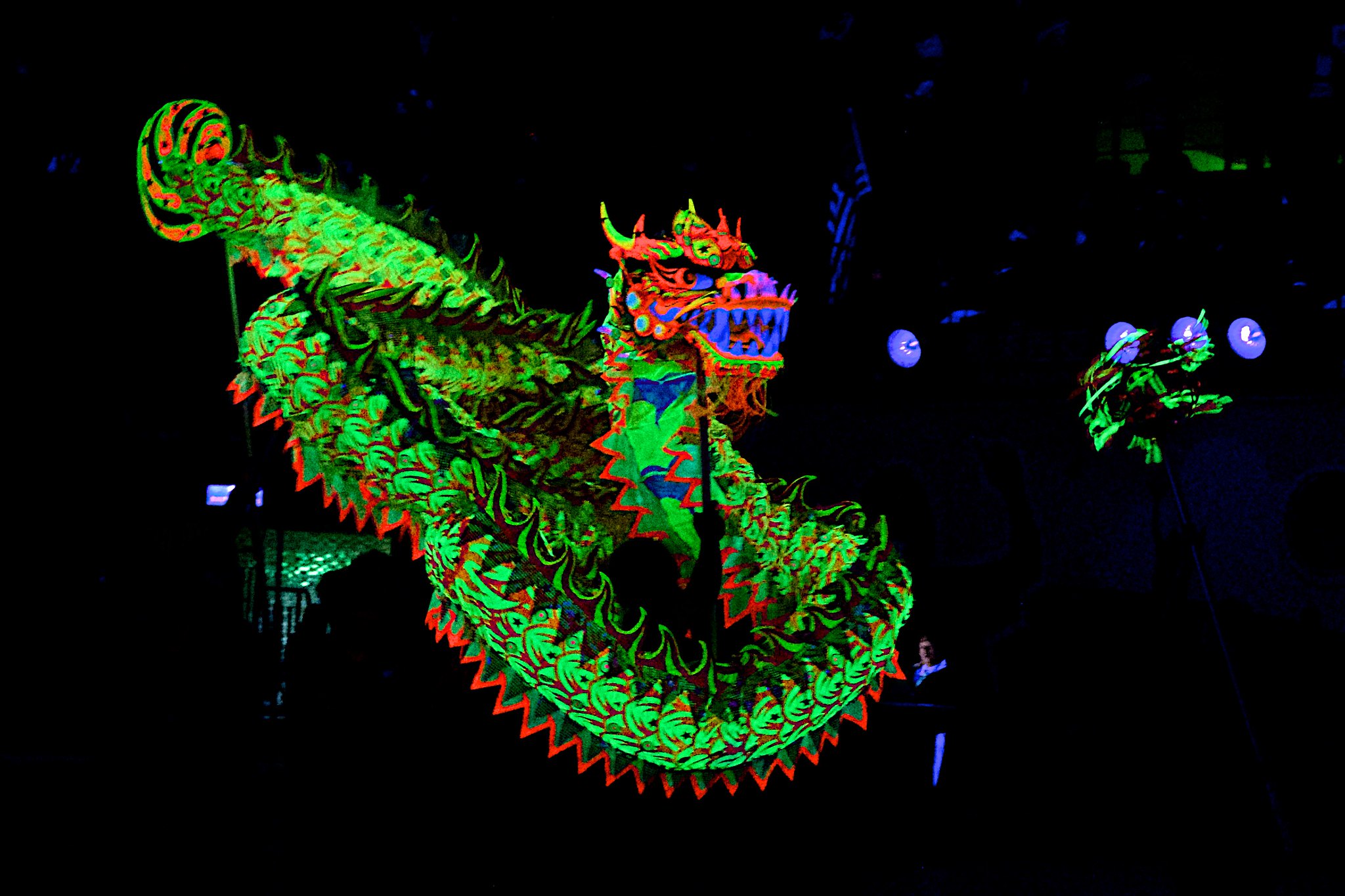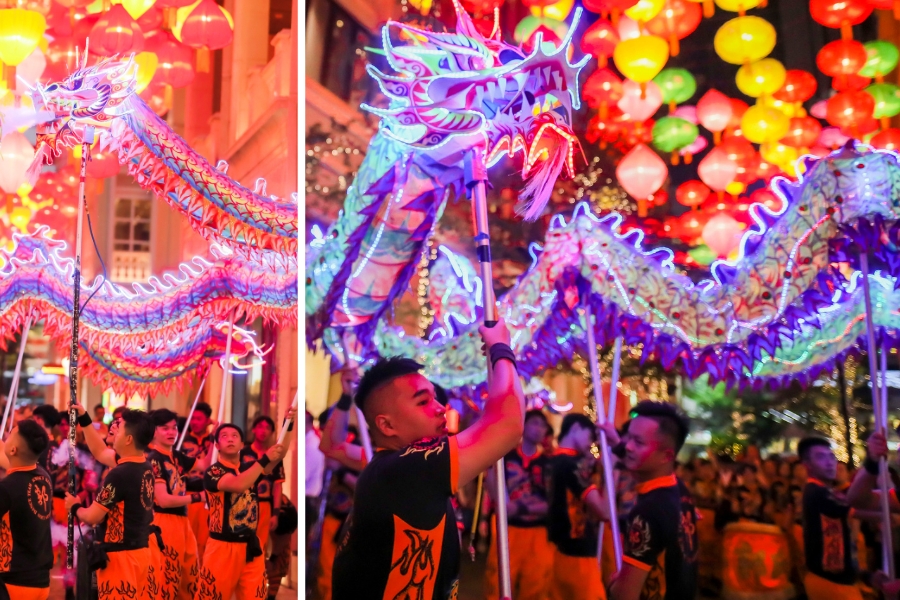For over three decades, Master Kwok Man-lung has been a beacon in the world of martial arts, dragon dance, and lion dance. His journey is a testament to the ever-evolving art of the dragon dance — a harmonious blend of rhythm, colour, and intricate choreography that is deeply intertwined with the tapestry of Chinese cultural traditions.
The dragon dance, originating from ancient practices, serves as a symbolic dance of power, honour, and aspirations for prosperity. But it isn’t all about the visual spectacle; it’s a dance of communal spirit and well-being. Throughout his illustrious career, Master Kwok — who began training in lion dance at the age of five and who leads the award-winning Kwok’s Kung Fu & Dragon Lion Dance Team — has witnessed transformative changes that marry the reverence for age-old traditions with the bold embrace of contemporary innovations, all while ensuring the dance remains relevant and captivating for new generations.
The HK HUB spoke with Master Kwok ahead of this year’s Mid-Autumn Festival celebrations, and got his take on how technology has changed the more than 2,000-year-old dragon dance, how the practice gives team members a sense of purpose and helps them create bonds that last a lifetime, and what he and his team have got planned for the festivities at Lee Tung Avenue, which will see the return of its iconic LED Fire Dragon Dance on September 29.
The Traditional Roots of Dragon Dances
The 1970s and 1980s were a period steeped in tradition. During these decades, martial arts and dragon dance were profoundly connected, creating a vivid tapestry of cultural display in Hong Kong. The streets buzzed with life, especially during festivals where two main forms of dragon dance were predominant, recalls Master Kwok.
The first, the “Fire Dragon 火龍”, was the centrepiece of the Mid-Autumn Festival in Tai Hang, its flames lighting up the night sky as it moved in swirling, undulating motions.

The second, the “Big Golden Dragon 大金龍”, was a massive and awe-inspiring spectacle, demanding coordination and strength from a large ensemble of dancers, and as Master Kwok remarks, “Due to its size, it can’t perform many fancy moves. Typically, it moves either in circles or figures of eight.”

The limited agility of these dragons meant that performances were often restricted to these patterns, but they were no less captivating.
Embracing Technology: The Glow and Radiance of Modern Dragons
By the mid-1990s, the world of dragon dance was on the cusp of transformation. The introduction of the “Night Illumination Dragon 夜光龍” from Singapore, with its origins in Fujian, China, heralded a significant shift in the practice. The dragon skin’s patterns, painted with fluorescent ink, glow when under UV or night illumination lights in dark environments, necessitating specific venues and lighting conditions during a performance.

This new dragon variant was not just a visual marvel, but also a representation of the fusion of cultures and designs. While Hong Kong dragons were known for their robust appearance and hanging cover, this new dragon, as Master Kwok points out, showcased the differences between northern and southern Chinese dragons, emphasising the smaller body and encased design of the northern variants that allowed for a wider range of “fancy moves, such as figures of eight, spiral jumps, and interweaving”.
This was a period of exploration, blending traditions, and evolving designs to create a more dynamic and versatile performance. The turn of the century brought with it technological advancements, and the realm of dragon dance was no exception.

The introduction of the “Night Illumination Dragon”, was just the beginning as the true revolution came with LED technology. As Master Kwok observes, “With the advancement of technology, LED lights can now be programmed, allowing for more dynamic transformations.” This innovation required performers to have enhanced physical fitness and technical skills. The coordination of the entire dragon became more challenging, leading to the emergence of more large-scale competitions.
The Evolution of Performance: From Simplicity to Sophistication
Master Kwok fondly recalls the simpler times of the 1980s, where passion and community spirit drove dragon dance performances. He reflects, “In the 1980s, people were happy to participate even without large dragons. They enjoyed the atmosphere, and the participants felt a sense of satisfaction.” But as the years rolled on, the world of dragon dance witnessed an evolution in both performance techniques and props.

The introduction of newer dragons, like the “Daylight Dragon 日光龍”, a type of dragon dance that focuses more on technique and skill, brought with it challenges and demands. Performers needed to be more agile, and the choreography grew in complexity. The dance was no longer just about tradition; it was about pushing boundaries and exploring new horizons.
Explaining the intricacy involved, Master Kwok says, “The dragon dance is both easy to learn and difficult to master,” pointing out that while the basic movements of dragon dance can be quickly grasped, mastering the art to a level where one can participate in competitions requires at least one to two years of dedicated training.
The challenge intensifies as performers, despite their physical differences, must synchronise their movements, breathing, and forms to present the dragon as a single, fluid entity. “Some individuals may have longer arms, longer legs, or move faster than others. However, when the entire dragon is performing as a unit, it should appear as a cohesive entity, resembling a living creature,” explains Master Kwok.
The Integral Role of Teamwork Resulting in Lifelong Bonds
Master Kwok emphasises the paramount importance of teamwork in dragon dance, a discipline that demands not only individual skill, but also seamless collaboration. According to him, achieving mastery and fluidity in performance requires intense practice, unity and synchronisation. “Blaming others solely is not an option. We need to be inclusive, encourage each other, and work together,” he states.
The process of achieving this level of cohesion is challenging, especially considering the diverse physical attributes of performers. Nonetheless, it is this challenge of moving in unison, of making the dragon dance, that makes the art form so compelling and rewarding for both performers and audiences alike. As Master Kwok vividly describes, “When the dragon spits out smoke, [the public] scream with excitement. For a performer, these are the greatest rewards and encouragement.”

Master Kwok’s team of around 40 members builds trust through a shared sense of purpose and mutual challenges. “Our team is passionate about participating in events and performances because we believe it helps our members grow by overcoming challenges and setbacks. The most important thing is that through performances and competitions, they gain a sense of fulfilment and confidence,” he says.
Master Kwok’s team members, who initially join through school programmes, evolve from individuals into a united group, developing trust, purpose, and multi-faceted skills over years of practice and performance. Through challenges, solutions-oriented approaches, and experienced coaching, members not only master the dragon dance, but also build lasting friendships and a sense of brotherhood. “After a couple of years and several competitions, they become more than just a dragon dance group — they become great friends and brothers,” says Master Kwok.
Meet Master Kwok at Lee Tung Avenue
In a testament to his relentless pursuit of excellence, Master Kwok’s recent LED dragon dance creation will take centrestage at Lee Tung Avenue this Friday, September 29, accompanied by workshops designed to introduce the captivating world of dragon dance.
One of the things that Kwok looks forward to most about the Lee Tung Avenue Mid-Autumn celebrations are the workshops he and his team conduct to teach the public about the various aspects of dragon dance. Kwok has picked movements from five major categories — Baat-zi “八字” (eight-character), Jau-lung “遊龍” (swimming dragon), Cyun-tang “穿籐” (interweaving), Zyu-tou “組圖” (in the form of a character), and Faan-gwan “翻滾” (rolling) — to introduce to participants.
“We chose several basic movements that can be easily picked up in just 30 minutes. We do it six times over the course of a day, and everyone is able to learn it and even do a simple performance in the end,” says Kwok, adding, “We are very grateful for this workshop because we hope to promote dragon dance, and introduce it to children and parents. When they come to watch the performance, they will have a greater sense of involvement and when they see the movements, they can proudly say, ‘I’ve learned that, I understand it.’”
The Dragon Dance performance will be held at Lee Tung Avenue on 29 September, 2023, from 8.30pm-9.30pm, and the workshops will be at 4pm, 4.45pm & 5.30pm (30 minutes per session).
Header image credits: Lee Tung Avenue




